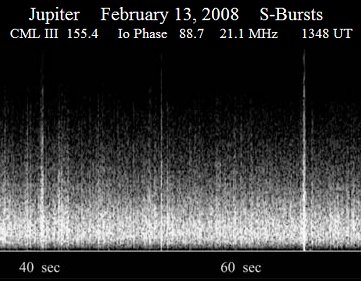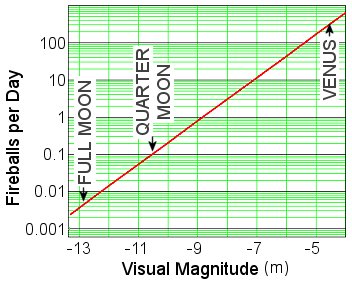| Where's Saturn? Is that a UFO--or the ISS? What's the name of that star? Get the answers from mySKY--a fun new astronomy helper from Meade. | |  | MORNING PLANETS: Set your alarm. On Wednesday morning about 45 minutes before sunrise, Venus and Mercury will gather together only 1o apart. Using binoculars, scan the southeastern horizon for Mercury hanging just above super-bright Venus: sky map. Two planets in one eyepiece--it's a good way to begin the day! photos: from Salvador Aguirre of Hermosillo, Mexico RADIO STORM ON JUPITER: On Feb. 13th, the loudspeaker of Thomas Ashcraft's 21 MHz radio telescope in New Mexico suddenly began to hiss and crackle. The sounds grew louder as Jupiter rose in the pre-dawn sky. "I am pleased to report," says Ashcraft, "a successful recording of Jovian S-bursts--the first of 2008." Click on the image to listen: 
The stacatto pops sound like lightning in the loudspeaker of a car radio, but lightning did not make these sounds. S-bursts are caused by natural radio lasers that form in Jupiter's magnetosphere and sweep past Earth as Jupiter rotates. Electrical currents flowing between Jupiter's upper atmosphere and the volcanic moon Io can boost these emissions to power levels easily detected by ham radio antennas on Earth. Jupiter is just finishing a weeks-long passage around the backside of the sun; now it is emerging into the pre-dawn sky in good position for radio observing. "Feb. 13th was one of the first opportunities to observe Io-storming this year," says Ashcraft. "It is encouraging for future monitoring of Jupiter in the months ahead." NEW YORK FIREBALL: "Last night, I was just out walking the dog when I saw a HUGE burning ball fly through the air, reports. Michele Kiefer of Ithaca, New York. "If the stars were the size of a pin prick, this object was the size of a quarter!" John Cook of Endicott, New York, witnessed the same thing: "It was glorious and really bright. There really was no missing it if someone was looking up." What was it? Answer: A garden variety fireball. Earth is under constant bombardment by small asteroids and other space debris, creating a drizzle of surprisingly-bright and -frequent meteors. According to calculations by NASA astronomer Bill Cooke, fireballs as bright as Venus appear somewhere on Earth more than 100 times daily. Fireballs as bright as a quarter Moon occur once every ten days, and fireballs as bright as a full Moon once every five months: 
The vast majority are never noticed. About 70% of all fireballs streak over uninhabited ocean. Half appear during the day, invisible in sunny skies. Many are missed, however, simply because no one bothers to look up. So grab a leash and a dog (optional), and head outside. The chance of a fireball is better than you think. GREENLAND FIREBALL: On Feb. 17th, a small and random asteroid disintegrated in the skies above Qaanaq (Thule) Greenland. "At first, I thought it was an airplane falling from the sky," says eyewitness Sara Lyberth. "There was a lot of fire and I immediately called the police." Moments later, police officer Farda Olsen took this picture of the meteor's smokey trail twisting in the wind. Radio Greenland offers a full account.
Lunar Eclipse Photo Gallery
[Interactive World Map of Eclipse Photos]
| 
